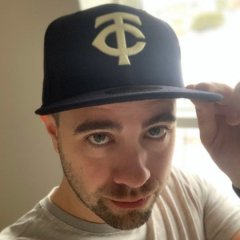
Twins Video
Cuddyer, who played in 1,139 games for Twins and was inducted into the team's Hall of Fame in 2017, is known for many things: His dimpled smile. His cannon arm. His magic tricks in the clubhouse. His slugging prowess.
From my view, there are two specific elements of Cuddyer the player that are worth reflecting on for Twins fans at this moment in time.
#1: Cuddyer is a poster child for the circuitous path to stardom
As a high school shortstop in Chesapeake, VA, Cuddyer emerged as one of the top prep talents in the country. The Twins selected him ninth overall in 1997. He went straight to Single-A and raked, ascending the minor-league ranks rapidly and bypassing Triple-A entirely on his way to an MLB debut at age 22. From 1999 through 2003 he was a perennial Top 100 prospect according to Baseball America, peaking at #17 in his last year of eligibility.
Cuddyer's initial ascent to the big leagues was as smooth as could be. His acclimation there was anything but. From 2001 through 2005, he yo-yoed back and forth between the majors and minors, continually crushing Triple-A but failing to establish himself at the highest level.
Not until he was 27 did Cuddyer finally turn the corner, posting an .867 OPS in 2006 with 24 homers, 41 doubles and 109 RBIs in a career-high 150 games. He was a key component of a team that won 96 games. From there he went on to slash .281/.347/.468 and hit 165 home runs over the remainder of his career, making two All-Star teams.
It's helpful to remember this path as we look at the various current Twins players who seem to be stuck in neutral (or worse). Byron Buxton and Miguel Sano, like Cuddyer, were both highly touted prospects that arrived in the majors at a young age but have failed to gain full traction. They're both 25 now.
Max Kepler, who follows Cuddyer in Minnesota's right field lineage, may be a more apt parallel. Like Cuddyer, Kepler earned himself a September call-up at age 22 following a monster year at Double-A. And like Cuddyer, Kepler's MLB production stagnated in the years following:
Michael Cuddyer, OPS+
2002: 95
2003: 97
2004: 100
2005: 97
2006: 124
Max Kepler, OPS+
2016: 96
2017: 95
2018: 96
2019: ?
Granted, Kepler hasn't really had to fight for his playing time like Cuddyer did; he's been a regular ever since he arrived, despite the unspectacular offensive numbers. This is, in part, because of his elevated defensive value. But don't despair too much about the lack of offensive progression so far. Out of Cuddyer's 17 Wins Above Replacement accumulated in the big leagues, 15 came after he turned 26. Kepler turns 26 on February 10th.
#2: Cuddyer was a model of defensive versatility
When I think about Cuddyer playing the field, I picture him out in right, gathering a carom off the Metrodome's baggy and spinning around to rifle it toward the infield. It's easy to forget, now, that he moved all over the place. In his career, Cuddyer played at least 500 innings at five different positions (RF, LF, 1B, 3B, 2B). He wasn't great at all of them, but having the option to plug him in at so many spots was a major convenience for Ron Gardenhire.
The current Twins will need to embrace this kind of flexibility, to the extent they can. Rostering a full-time DH like Nelson Cruz puts a further crunch on what'll likely be a short bench. Rocco Baldelli's life will be made easier if some players are able to help out at multiple positions, as Cuddy did.
This is another possible connection to Kepler. I've suggested before that it'd be wise to get him up to speed at first base, given his past experience there. Eddie Rosario's brief but flashy appearance in the infield last year may have had substance (he did play second for a spell in the minors). Jonathan Schoop would be an even bigger asset if he could step in at third here and there to spell Sano.
I'd like to hear about how Cuddyer kept his skills sharp enough that even at age 32, in his last season with the Twins (2011), he was able to make 41 starts at first base and 17 at second, in addition to his 77 games in right field. I also want to hear about how he dealt with the discouragement of setbacks and sideways progress over four years between reaching the majors and becoming a true bona fide big-leaguer. These insights are not only compelling to the longtime Twins fan in me who enjoys reminiscing upon the team's greatest era of my lifetime, but also for the forward-looking fan in me who sees similar scenarios playing out before my eyes.
Fortunately, I'll have a chance to hear Cuddyer talk about these topics and more on January 26th at the Winter Meltdown, along with all of you who are able to attend. For those who aren't, the Q&A session will (hopefully) be available via John and Aaron's podcast.
Feel free to share your favorite Cuddyer memories in the comments section – especially if you can connect them to any current Twins narrative.
MORE FROM TWINS DAILY
— Latest Twins coverage from our writers
— Recent Twins discussion in our forums
— Follow Twins Daily via Twitter, Facebook or email
— Become a Twins Daily Caretaker






Recommended Comments
Join the conversation
You can post now and register later. If you have an account, sign in now to post with your account.
Note: Your post will require moderator approval before it will be visible.